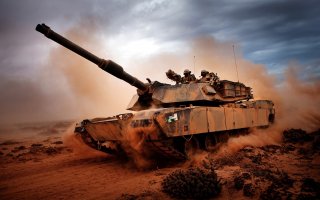Turkey Wants a Tank of Its Own. But Can They Pull It Off?
Perhaps tired of depending on foreign tank procurement, and exacerbated by Turkey’s many recent kerfuffles with NATO Allies, Ankara has turned inward. Their Altay main battle tank, built and (mostly) designed in Turkey, could remedy this situation.
Here's What You Need to Remember: Despite being trumpeted as an all-Turkish design, the Altay tank leans heavily on a number of foreign components. In particular, the Altay program would like to have copied the engine and transmission that South Korea’s K2 tank uses, of a German design. This may prove to be impossible.
Putting it simply, Turkish armor isn’t exactly the most modern. In addition to early Cold War-era American M48 and M60 tanks, Turkey also fields several German-built Leopard 1 and Leopard 2 main battle tanks. Though fairly formidable when introduced in the mid-1960s and the late 1970s respectively, both have since grown long in the tooth, facing several embarrassing setbacks in combat.
Perhaps tired of depending on foreign tank procurement, and exacerbated by Turkey’s many recent kerfuffles with NATO Allies, Ankara has turned inward. Their Altay main battle tank, built and (mostly) designed in Turkey, could remedy this situation.
Turkey’s Altay main battle tank seems to be standard fare in the world of main battle tanks. It sports a 120mm Rheinmetall main gun. It also has a .50 caliber heavy machine gun and a 7.62mm medium machine gun as secondary weapons. Its 1,500 horsepower engine provides enough output to comfortably propel the sixty-five or so ton tank around. It is even protected by a locally sourced and developed Roketsan armor package. On paper at least, nothing is amiss.
Except for the fact that the tank remains mostly on paper.
Turkish-made?
Despite being trumpeted as an all-Turkish design, the Altay tank leans heavily on a number of foreign components. In particular, the Altay program would like to have copied the engine and transmission that South Korea’s K2 tank uses, of a German design. This may prove to be impossible.
Due to tensions between Berlin and Ankara as well as a German arms embargo against Turkey, Turkish negotiations with German defense firms soured, sinking plans for the German-designed engine and transmission. Turkey, a non-European Union member, has faced criticism from a number of EU countries due to Turkey’s involvement in the Syrian civil war. What exactly will be used in place of the German design remains to be seen.
Compounding problems the Altay program has faced is its armor package. Altay prototypes and initial tanks had benefited from a French armor package. French-assisted armor is now in jeopardy thanks to Turkey’s recent aggressiveness in the Mediterranean, which Paris has recently tried to discourage.
In 2019, Turkish officials set an ambitious, two-year timeline for the Altay program, stating that by 2021, the main battle tank would be fielded. This timeline would now appear to be virtually impossible thanks to Turkish alienation.
Postscript
Whether or not Ankara can work out the component sourcing for their Altay program, one thing is for certain. Despite strong assertions to the contrary, the Altay won’t be a purely domestic initiative. Still, if the engine and transmission issue can be rectified, and an adequate armor package sourced, Turkey would be able to have a tank in service that could easily outstrip its older tanks in terms of performance and capabilities. Watch this topic closely for further additional information.
Caleb Larson is a defense writer for the National Interest. He holds a Master of Public Policy and covers U.S. and Russian security, European defense issues, and German politics and culture.
Image: Reuters

